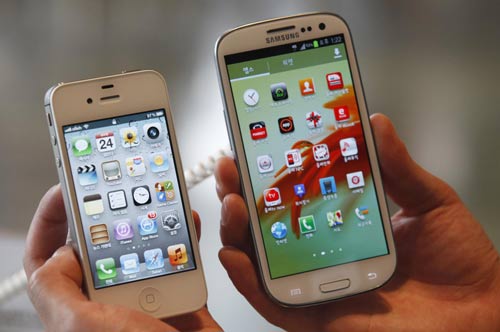Apple and Samsung, frenemies for life
Updated: 2013-02-12 11:27
(Agencies)
|
||||||||
|
 An employee holds Apple's iPhone 4s (L) and Samsung's Galaxy S III at a store in Seoul in this file photo from August 24, 2012. [Agencies] |
The memory market in 2005 was extremely unstable, and Apple wanted to lock in a supplier that was rock-solid financially, people familiar with the relationship said. Samsung held about 50 percent of the NAND flash memory market at that time.
"Whoever controls flash is going to control this space in consumer electronics," Jobs said at the time, according to a source familiar with the discussions.
The success of that deal led to Samsung supplying the crucial application processors for the iPhone and iPad. Initially, the two companies jointly developed the processors based on a design from ARM Holdings Plc, but Apple gradually took full control over development of the chip. Now Samsung merely builds the components at a Texas factory.
The companies built a close relationship that extended to the very top: in 2005, Jay Y. Lee, whose grandfather founded the Samsung Group, visited Jobs' home in Palo Alto, California, after the two signed the flash memory deal.
The partnership gave Apple and Samsung insight into each other's strategies and operations. In particular, Samsung's position as the sole supplier of iPhone processors gave it valuable data on just how big Apple thought the smartphone market was going to be.
"Having a relationship with Apple as a supplier, I am sure, helped the whole group see where the puck was going," said Horace Dediu, a former analyst at Nokia who now works as a consultant and runs an influential blog. "It's a very important advantage in this business if you know where to commit capital."
Samsung declined to comment on its relationship with a specific customer.
As for Apple, it reaped the benefit of Samsung's heavy investments in research and development, tooling equipment and production facilities. Samsung spent $21 billion (23 trillion won) on capital expenditures in 2012 alone, and plans to spend a similar amount this year.
By comparison, Intel Corp spent around $11 billion in 2012, and Taiwan Semiconductor Manufacturing Co Ltd (TSMC) expects to spend $9 billion in 2013.
But component expertise, cash and good market intelligence did not assure success when Samsung launched its own foray into the smartphone market. The Omnia, a Windows-based product introduced in 2009, was so reviled that some customers hammered it to bits in public displays of dissatisfaction.
Meanwhile, Samsung publicly dismissed the iPhone's success.
"The popularity of iPhone is a mere result of excitement caused by some (Apple) fanatics," Samsung's then-president, G.S. Choi, told reporters in January 2010.
Privately, though, Samsung had other plans.
"The iPhone's emergence means the time we have to change our methods has arrived," Samsung mobile business head J.K. Shin told his staff in early 2010, according to an internal email filed in US court.
Later that year, Samsung launched the Galaxy S, which sported the Android operating system and a look and feel very similar to the iPhone.
Standoff
Jobs and Cook complained to top Samsung executives when they were visiting Cupertino. Apple expected, incorrectly, that Samsung would modify its design in response to the concerns, people familiar with the situation said.
Apple's worst fears were confirmed with the early 2011 release of the Galaxy Tab, which Jobs and others regarded as a clear rip-off of the iPad.

 Li Na on Time cover, makes influential 100 list
Li Na on Time cover, makes influential 100 list
 FBI releases photos of 2 Boston bombings suspects
FBI releases photos of 2 Boston bombings suspects
 World's wackiest hairstyles
World's wackiest hairstyles
 Sandstorms strike Northwest China
Sandstorms strike Northwest China
 Never-seen photos of Madonna on display
Never-seen photos of Madonna on display
 H7N9 outbreak linked to waterfowl migration
H7N9 outbreak linked to waterfowl migration
 Dozens feared dead in Texas plant blast
Dozens feared dead in Texas plant blast
 Venezuelan court rules out manual votes counting
Venezuelan court rules out manual votes counting
Most Viewed
Editor's Picks

|

|

|

|

|

|
Today's Top News
Boston bombing suspect reported cornered on boat
7.0-magnitude quake hits Sichuan
Cross-talk artist helps to spread the word
'Green' awareness levels drop in Beijing
Palace Museum spruces up
First couple on Time's list of most influential
H7N9 flu transmission studied
Trading channels 'need to broaden'
US Weekly

|

|







